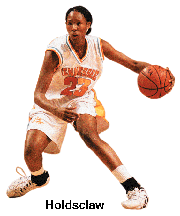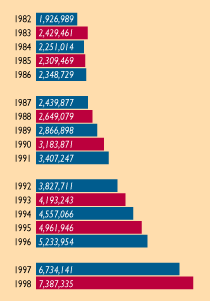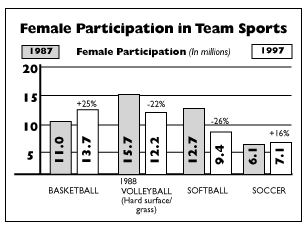The NCAA News - News and Features
The NCAA News -- December 21, 1998
Ball is bouncing up for women's basketball
BY KAY HAWES
STAFF WRITER
 It's a hot ticket all the way around. It's a hot ticket all the way around.
While the women's basketball world awaits a classic matchup January 10 between No. 1-ranked Connecticut and the defending national champion, No. 2-ranked Tennessee, the entire game is booming.
With two professional leagues, record-setting interest in AAU leagues and a college game that features teams like the Huskies (averaging 101.3 points an outing) and the Lady Vols (who hold the record for average home attendance), basketball is enjoying popularity never before seen by a women's sport.
Highlights of women's college games are on cable sports shows, little girls lecture WNBA superstars in athletics shoe commercials, and some women's college teams are outdrawing the men's teams. And, since the women's gold medal in the 1996 Olympics, little girls have been taking to the playground decked out in team jerseys that have a woman's name on the back.
Only 17 years ago, all of this would have been almost impossible to predict. Yet, there are those who say that women's basketball has only just begun, that it has the potential to appeal to more players, to more spectators and to a greater television audience. Perhaps the question shouldn't be, 'How did it get this big?' but instead, 'How much bigger can it get?'
Humble beginnings
 Women's basketball has come a long way since 1892, when gymnastics instructor Senda Bereson Abbott adapted James Naismith's game for her female students at Smith College. Women's basketball has come a long way since 1892, when gymnastics instructor Senda Bereson Abbott adapted James Naismith's game for her female students at Smith College.
From the first basketball championship held by the Association of Intercollegiate Athletics for Women in 1972 to the first NCAA championship game in 1982, women's basketball has continued to change and grow.
Women's basketball has been affected by everything from Title IX to the advent of the three-point shot and weight training. Grandmothers of today's college players learned a game with six on a team, and mothers of today's players had to wait until the boys were finished before they could take to the gym.
Today's players start playing the game at an earlier age, and they have school teams, summer leagues and summer basketball camps.
According to the American Basketball Council, basketball has overtaken volleyball as the most popular team sport among females.
Also according to the council, between 1987 and 1997 the number of women who played basketball increased 25 percent, from 11 million to 13.7 million. The number of females who play basketball frequently (52 or more days a year) increased 73 percent from 1987 to 1997.
And, for the first time, the number of girls registering for Amateur Athletics Union basketball exceeded the number of boys registering to play basketball.
In the stands
 Just as there has been more interest in playing women's basketball, there has been more interest in watching it. Just as there has been more interest in playing women's basketball, there has been more interest in watching it.
Last year Tennessee averaged 14,969 fans per home game. Connecticut and Wisconsin averaged 10,744 and 10,455, respectively.
Several teams have set single-game records that have topped 20,000. The Division I women's record for single-game attendance is 24,597, set at the Tennessee-Connecticut game January 3, 1998, at Tennessee. This year's return matchup at Connecticut is already sold out.
Not to be outdone by the regular season, the NCAA tournament and the Women's Final Four have grown greatly in popularity over the years.
Last year, 17,976 fans saw the NCAA Division I women's championship finals in person, with 285,428 spectators attending the entire tournament, 59,505 more than the previous year.
In the game's first year as an NCAA championship, only 7,766 people attended the final game and only 66,924 attended the entire tournament. Now the top teams draw 13,000 or 14,000 fans to a single home game.
Media attention matters
While today's young people may think nothing of watching their favorite college team play on television several times a year, or reading about their favorite teams in magazines and newspapers, it hasn't always been so easy.
"People really see women's basketball as a legitimate event now," said Tricia Bork, NCAA vice-president for championships, who has worked with the women's championship in some capacity since 1984.
"The product is so much better. The skill level is so much better. But the biggest change I've seen is in media attention.
"In the early '80s, we were credentialing 50 members of the media (for the championship). That number is closer to 400 this year. That in turn has fueled the increased attendance."
 Bork said that at one time women's basketball was not "a desirable product." Bork said that at one time women's basketball was not "a desirable product."
"At one time, our women's championship was only televised because we said, 'If you want the men's, you have to take the women's,' " she said.
This year ESPN and ESPN2 will televise 52 Division I women's basketball games, including the NCAA tournament. In 1982, the first year women's basketball appeared on ESPN, only five games were televised.
"The number of women's televised games has increased dramatically," Bork said. "So many conferences now have television packages for their women's basketball."
Nora Lynn Finch, senior woman administrator and senior associate athletics director at North Carolina State University, agreed. "I would say where we've had the greatest growth is in television coverage," she said.
As the first chair of the Division I Women's Basketball Committee, Finch remembers when network interest in women's basketball was in the cellar.
"For the first few years, only the women's championship game was televised," she said. "And the only way they would televise the game was if it would fall on the day between the men's semifinals and finals."
Other members of the media were not eager to cover the women's game, either. "The print media (at the Women's Final Four) has expanded enormously," Finch said. "In the early years, we tried to get people to sit there and look like they were media.
"Our goal was to make it a happening, make it an event. And that's what it is now."
Finch also noted that one individual's work over the years has been instrumental in helping the NCAA women's championship.
"If you wanted to point to a person who has really helped foster the women's championship to this point, you have to look at Tricia Bork and her unbelievable dedication to the championship," Finch said. "Her ability to provide continuity, from year to year and from committee to committee, has made a difference. She doesn't make policy, she just keeps things balanced and keeps it focused."
Finch also pointed to the advent of corporate partnership as a major development in the championship.
"The power of corporate partnership is measurable," she said. "I remember when we chose the official ball. Now it isn't just a ball, it's a soft drink, a communications company, a retailer."
Television exposure and corporate interest is a measure of success, says Bernadette V. McGlade, current chair of the Division I Women's Basketball Committee and assistant commissioner of the Atlantic Coast Conference.
"The advent of the ESPN TV contract for the women's championship leap-frogged the championship to a whole new level in terms of national attention," she said.
At one time, there was talk of moving the women's NCAA championship -- and possibly even the entire women's season -- to avoid sharing that national attention with the men.
"There's a pretty strong consensus that moving women's basketball season into the fall where it would go head-to-head with football would not be in the best interests of women's basketball," McGlade said.
"But if the Women's Final Four could be moved one week in either direction, who knows? We have talked to ESPN about moving it up or back. The committee had a preliminary discussion and looked at future calendars in the next century. Right now it's a very crowded schedule."
If the game is moved up a weekend, it would be up against men's regional coverage. Back a weekend and it's into baseball and the perception that the season is over because the men's season is over.
"Right now, the advantages of moving aren't compelling enough," Bork said.
"There isn't a television reason to move it. ESPN can't tell us what other sports we'd be up against. And, there is some inherent benefit to being on the same weekend as the men because it's Final Four weekend."
Why basketball?
While the statistics speak to the popularity of the sport, both from the players' perspective and the fans' perspective, they don't address the question, why basketball? Why is it the women's sport with the marquee names and the most media attention?
Bork points to sponsorship statistics, both at the high-school level and at the college level.
According to statistics provided by the National Federation of State High School Associations, basketball is the most-sponsored high-school sport for boys or girls, and it has the most participants of any girls' sport--454,000 this year.
NCAA statistics show that 306 of 312 Division I institutions sponsor women's basketball, with 288 out of 297 Division II institutions and 408 out of 422 Division III institutions also sponsoring.
Bork also points to the efforts of institutions and conferences to promote women's basketball. "The resources they're pouring in at a grass-roots level, that makes a difference," she said. "Also, you've got to credit the coaches and players, because this is a better product."
Beth Bass, executive director of the Women's Basketball Coaches Association, says basketball has benefited from pioneers in other sports.
"We have to tip our hats to those in the individual sports that led the way, like women's professional tennis and women's professional golf," Bass said. "They were forerunners in showing that women's sports can be profitable."
The potential for profit is important, and so is a willingness to put resources into the sport.
"What we're seeing with basketball now," said Donna Lopiano, executive director of the Women's Sports Foundation, "is the result of schools putting the same kind of energy and resources into women's basketball as they did into men's basketball and football."
Added Lopiano, "I think (women's basketball) was the only sport that male athletics directors understood as a revenue-producing possibility."
Lopiano also looks at the last 25 years since Title IX as a natural progression that should have led to the popularity of some women's sports.
"The influential occurrences, like the 1996 Olympic performances of the women's basketball, softball and ice hockey teams, were not idiosyncratic events. They were the sum total of 25 years of giving women a chance to play."
It does go back to Title IX and those who first saw the potential in women's basketball," McGlade said. "Ev-
erything is paying off for women's basketball," she said. "We're seeing the dividends of all of the hard work of people who have pioneered and laid the groundwork for women's athletics. There is an expectation on the student-athletes' part now that there should be equal opportunity across the board. The students who are playing now, they never think about not having that opportunity. That mind-set is worth more than anything."
McGlade also said the sport is popular because it's fast and fun.
"I think that's why you see the increase in attendance all across the country," she said. "It's accessible. It's a sport that doesn't discriminate. It's accessible to kids in the city, it's accessible to kids in the country, it's indoor or outdoor. It's available to all races, all people, all economic levels.
"And, it's a good buy. It's not cost-prohibitive. You can take a family of four or five and enjoy a well-played game. The kids can enjoy the band and the college game atmosphere."
As more women's games sell out, there may be less access.
"The sport is growing up," McGlade said. "High attendance has trickled down to the regional (tournaments) and down to the campuses. I think we'll see more programs continue to have more sellouts. Less accessibility will be a growing pain, but one that everyone will welcome."
Bigger still?
If statistics showing youth interest are any indication, the sport of women's basketball can get bigger, probably much bigger.
"I definitely think the progress has been amazing, but we're not there yet," Bork said. "And, it's not that our audience is just women. It's a good demographic. Women's basketball is real attractive to families."
A study conducted by The Taylor Research & Consulting Group showed that 31 percent of consumers age 9-55 -- 55.8 million Americans -- consider themselves fans of women's college basketball. And, there was a statistically equal level of interest in women's college basketball among men and women.
There also is more corporate and municipal interest in future events that most fans haven't even thought about yet.
"Society at large is understanding that (the Women's Final Four) is a big event," Bork said. "There's an increased interest by sports commissions and by cities in the bid process to host it. In the early years, we had maybe two choices. Last year 60 cities bid for it in 2001 and 2002."
Finch sees the women's basketball championship as leading the way for the growth of other women's sports.
"I see the women's basketball championship as the flagship," she said. "But if we can't get it done on the basketball side, where will we be with the women's volleyball championship or the women's soccer championship?
"I still see it as a grander party than it is. It's not there yet. It's a long way from where it was 17 years ago, but my vision of where it ought to be is not where it is yet."
One of the next milestones for the women's Division I championship will be in 2002, when it will be held in San Antonio in the Alamo Dome.
"It will be the first time that the women's championship will be played in a dome," McGlade said. "It is such a great facility. The championship was awarded based on a seating capacity of just over 25,000, but (the seating) can be configured up or down from that point."
Rocky Top at the top
One school that would be tickled orange to see their fans packing that dome is Tennessee.
For many people and many programs, the Lady Vols are an example of what women's basketball can be and perhaps what it will be like in the future.
As the team has taken home a total of six national Division I championships, the last three in the last three years, the Lady Vols have set records for home attendance and even made a profit.
"We averaged right at 15,000 people last year," said Joan C. Cronan, the Tennessee women's athletics director, "and we cleared close to half a million."
The Lady Vols sold 7,600 season tickets last year, and they have sold 11,500 this year. Lady Vol merchandise also is in demand.
Making a profit is the goal of many women's programs, but it is difficult to do since expenses keep rising.
"It's tough to make a profit in sports, especially women's sports," Cronan said. "But we said yes to women's basketball before that was cool, and over the years we've worked extremely hard to develop a product that people want to buy."
Tennessee was able to turn a profit without skimping on expenses. The head coach, Pat Head Summitt, is reported by The Chronicle of Higher Education to be the highest-paid women's coach in the country at nearly $400,000 a year.
Also worth mentioning is the Lady Vols commitment to graduation.
"Every lady who has played for Pat Summitt for four years has graduated," Cronan said. "I see my job as No. 1, in education. We're here to get these women a college degree. No. 2, we're also a business. I'm a businesswoman. My goal every year is to be in the black. And, we're also in the entertainment business. This year we've instituted an NBA-type game entrance with lights, lasers and smoke."
Next up for the Lady Vols? They're working on their game above the rim. Freshman Michelle Snow has dunked in high school and in practice, and she has inspired the rest of the team to work on developing the skill.
Is there a downside?
As women's basketball begins to make money, the danger exists that the perils surrounding major men's sports will surround it as well.
"Coaches of women's teams have never had a corner on the morality market," Lopiano said. "As the pressures go up, the likelihood of corruption will increase. That's true for men and women."
Bass agreed. "We're going to have the same issues and the same challenges as the men's game," she said. "With success comes some baggage."
Coaches and boosters also may be tempted to take short cuts.
"As you have more recruiting going on nationally and more visibility with more pressure to win and more potential for making money, the potential for more violations increases," said Charles E. Smrt, NCAA director of enforcement.
While Smrt has not seen an increase in major violations in women's sports, three institutions are on probation because of issues relating directly to their women's basketball programs.
"Our efforts in women's basketball are similar to our efforts in men's basketball and football," Smrt said. "But we're not getting any more information about potential violations in women's basketball now than we have in the past."
But there are some indicators that gambling on women's games is increasing, said William S. Saum, the NCAA's agent and gambling representative.
"For the last five years the casinos in Las Vegas have put up a line on the women's championship game," Saum said. "But for the last two years they have put a line up on every game in the tournament."
Saum also says law enforcement officials in areas near top teams have noticed that illegal bookmakers are taking bets on the top women's programs.
"People like to wager on what they see on TV, and obviously women have made great strides in this area," Saum said.
The NCAA is working to stay ahead with preventive programs. "What we're trying to do is to do the same in women's basketball as in men's basketball," Saum said. "We want to stay on the cutting edge of it."
In another sign of the times, officials at Tennessee have had to shoo away agents who have come sniffing around their program. No doubt that will increase as Chamique Holdsclaw nears graduation.
In a way, the interest given to her and to other talented women players is a compliment to the game.
"I think Chamique will be one of the most sought-after women athletes ever," Cronan said. "Our job is to prepare her and protect her -- her and all of our student-athletes.
"I will take that challenge as opposed to having to mop the floor before the game and hoping three people show up to watch. I will take that challenge every time."
|